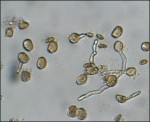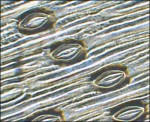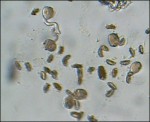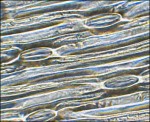Here are two tazetta clones from Mallorca. The pollen volume of the second one is about twice the volume of the first one. The stomata of the second one are longer and they lay more far from each other. This means the plant is triploid or tetraploid and develops diploid pollen grains. It may be useful to cross it with tetraploid garden daffodils to get fertile descendants. The probability that it is triploid is much greater than that it is tetraploid.
The triploids come into existence in a field of a diploid species when a normal haploid gamete combines with an unreduced gamete which sometimes occurs. These triploids normally are unfertile, but some can produce few haploid or diploid pollen. When the diploid pollen of this daffodil combines with an unreduced egg cell of another daffodil a tetraploid plant originates.
I shall ask Ben Zonneveld if he may determine the nulear DNA content of the plants. These values indicate whether the plant is triploid or tetraploid.






